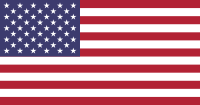The United States of America
- Capital: Washington, D.C.
- Largest city: New York City
- Population: 325.000.000
- Area: 9.800.000 km2
- National language: English
- Currency: United States dollar
History
- 15.000 years ago or earlier – first people came to North America using Bering land bridge, which formed during the ice age (large volume of water was contained in the icebergs, and thus sea level was lower)
- Approx. 1000 – Vikings led by Leif Eriksson discovered North America (most likely Newfoundland)
- 1492 – Christopher Columbus discovered North American islands (e.g. Hispaniola, Cuba, San Salvador...)
- 16th-18th century – foundation of Spanish (Florida, New Mexico), French (Mississippi basin), Dutch (part of the East Coast), Sweden (lower reaches of the Delaware River) and English (Virginia) colonies. Inhabitants of English colonies were mainly Christian dissenters seeking religious freedom.
- 1732 – colonization of Georgia, the last colony of Thirteen Colonies.
- 1754-1763 – French and Indian War (part of Seven Years' War) – ended by Treaty of Paris – Britain gained control of Canada (former French territory). Spain traded Florida to Britain in order to regain Cuba. The Seven Years' War significantly increased Great Britain's national debt. The government tried to compensate the financial loss by imposing new taxes on American colonies. Colonists disagreed with the new taxes since they did not have any representatives in the Parliament. The tax collection was then enforced by British soldiers resulting in several incidents, e.g. Boston Massacre a Boston Tea Party.
- 1775-1783 – American Revolutionary War – Twelve colonies formed a Continental Congress to coordinate their resistance against the British. The Continental Congress appointed George Washington to command the Continental Army and voted for independence on July 2, 1776. On the 4. July the Congress issued the United States Declaration of Independence written by Thomas Jefferson. The deceleration was signed by representatives of all Thirteen Colonies. In 1778 Americans formed an alliance with France. The British were defeated at Saratoga (1777) and Yorktown (1781). The war ended on September 33, 1783 by Treaty of Paris in which Great Britain agreed to recognize the sovereignty of the United States.
- 1788 – United States Constitution was ratified by all thirteen States
- 1789 – George Washington became the first president elected under the new constitution
- 1791 – United States Bill of Rights was adopted, forbidding restriction of personal freedoms
- 1812 – War of 1812 – war between the United States and Britain. The United States tried to conquer Canada, however, its attempt was unsuccessful. The war ended with 'status quo'.
- 1861-1865 – American Civil War – war between Northern and Southern states caused by different opinions regarding slavery. After the election of Abraham Lincoln, the thirteen slave states declared secession and formed Confederate States of America (the "South"), while the federal government (the "Union") considered the secession to be illegal. The war ended by victory of the Union.
- 1917-1918 – US participated in the First World War on the side of Allies of world War I
- 1941-1945 – US participated in the Second World War on the side of Allied Powers
Geography
The United States are located in North America. The country lies between the Pacific (in the West) and Atlantic Ocean (in the East). It shares international borders with Canada (to the north of the contiguous United States and to the east of Alaska) and Mexico (to the south). Alaska is separated from Asia by the Bering Strait.
The East coast of The United States consists of plains which gradually change into forests and the Piedmont plateau. The Appalachian Mountains divide the eastern coast from the Great Lakes (Lake Superior, Michigan, Huron, Erie and Ontario) and the grasslands in the Midwest. Famous Niagara Falls are located on the Niagara river, which drains Lake Erie into Lake Ontario. Lake Ontario is connected to Atlantic ocean by Saint Lawrence River. The Mississippi–Missouri River is located in the center of the country and forms the world's fourth longest river system. West of the Mississippi river lie the Great Plains, an important agricultural region. The Rocky Mountains, at the western edge of the Great Plains, extend north to the south across the mountains. Farther west are the rocky Great Basin and several deserts. The Sierra Nevada (which includes the highest mountain in the contiguous US – Mount Whitney) and Cascade mountain ranges run close to the Pacific coast. The highest mountain of the United states is Mount Denali (6168 meters above sea level, formerly known as Mount McKinley), which is located in Alaska.The lowest point of US is Death Valley (86 meters below sea level).
The United States includes most of the climate types. The North of the contiguous united states is located in the zone of temperate climate. However, the average temperatures are lower than temperatures on corresponding latitudes in Europe due to cold Labrador Current in the North Atlantic Ocean. The center of the country experiences drier, continental climate. The South of the country lies in subtropics. Alaska experiences subarctic climate, while Hawaii is located in tropics.
